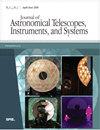罗马太空望远镜日冕仪的端到端数值模拟
IF 3.1
3区 工程技术
Q2 ENGINEERING, AEROSPACE
Journal of Astronomical Telescopes Instruments and Systems
Pub Date : 2023-10-11
DOI:10.1117/1.jatis.9.4.045002
引用次数: 2
摘要
罗马太空望远镜将拥有太空中第一个先进的日冕仪,具有用于波前控制(WFC)的可变形镜(dm),低阶波前传感和维护,以及光子计数探测器。预计它将能够在反射可见光中探测和表征成熟的巨型系外行星。在过去的十年中,日冕仪在其飞行环境中的性能已经通过越来越详细的衍射和结构/热有限元模型进行了模拟。该仪器目前正在集成中,准备在未来几年内发射,本文描述了端到端建模的现状,包括测量的飞行部件,如dm。日冕模式,包括最容易从模拟中得到的特征,被详尽地描述。详细介绍了衍射传播、WFC以及结构和热有限元建模的方法。为该仪器开发的技术和程序将作为未来日冕探测任务的基础,如宜居世界天文台。本文章由计算机程序翻译,如有差异,请以英文原文为准。
End-to-end numerical modeling of the Roman Space Telescope coronagraph
The Roman Space Telescope will have the first advanced coronagraph in space, with deformable mirrors (DMs) for wavefront control (WFC), low-order wavefront sensing and maintenance, and a photon-counting detector. It is expected to be able to detect and characterize mature, giant exoplanets in reflected visible light. Over the past decade, the performance of the coronagraph in its flight environment has been simulated with increasingly detailed diffraction and structural/thermal finite-element modeling. With the instrument now being integrated in preparation for launch within the next few years, the present state of the end-to-end modeling, including the measured flight components such as DMs, is described. The coronagraphic modes, including characteristics most readily derived from modeling, are thoroughly described. The methods for diffraction propagation, WFC, and structural and thermal finite-element modeling are detailed. The techniques and procedures developed for the instrument will serve as a foundation for future coronagraphic missions, such as the Habitable Worlds Observatory.
求助全文
通过发布文献求助,成功后即可免费获取论文全文。
去求助
来源期刊

Journal of Astronomical Telescopes Instruments and Systems
Engineering-Mechanical Engineering
CiteScore
4.40
自引率
13.00%
发文量
119
期刊介绍:
The Journal of Astronomical Telescopes, Instruments, and Systems publishes peer-reviewed papers reporting on original research in the development, testing, and application of telescopes, instrumentation, techniques, and systems for ground- and space-based astronomy.
 求助内容:
求助内容: 应助结果提醒方式:
应助结果提醒方式:


